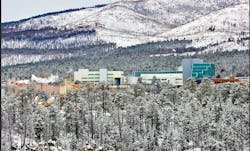Data-Driven Strategies
By Christina Chavez, Contributing Author
Nestled among the peaks of New Mexico's Pajarito Plateau lies the town of Los Alamos, a place with a unique history and a distinct set of challenges, especially when winter descends upon its rugged landscape.
From its beginnings as a secret hub for nuclear research during World War II to its present-day status as home to one of the nation's premier research laboratories, Los Alamos has weathered many storms, literal and metaphorical.
Placed amidst dramatic topography, Los Alamos is accessible via three main roadways that wind through switchbacks along cliffside routes. The town sits atop the Pajarito Plateau, characterized by volcanic tuff formations sculpted by ancient eruptions.
Deep canyons divide the landscape, a testament to the erosive power of water runoff from the nearby Sierra de los Valles. Most of the town perches atop mesas, with an elevation around 7,500 feet, while White Rock lies at the base, approximately 7,000 feet above sea level.
Los Alamos experiences a temperate mountain climate marked by four distinct seasons. Autumn brings cooler, drier weather, while winter sees mid-latitude storms dusting the landscape with snow for several months. Snowfall averages around 28 inches annually, with January temperatures ranging from 17 F to 40 F and July temperatures from 55 F to 81 F.
Despite its sunny reputation, Los Alamos has seen extremes, with record highs of 95 F and lows plunging to minus 18 F.
At the heart of Los Alamos lies its crown jewel, the Los Alamos National Laboratory (LANL). Boasting nearly 18,000 employees, with 12,400 working onsite, LANL stands as the largest employer in New Mexico outside the state itself. As a key player in the National Nuclear Security Administration, LANL's mission revolves around maintaining and safeguarding the nation's nuclear arsenal.
Winter weather poses a unique set of challenges for LANL. It affects materials, resources and finances. The laboratory employs a specialized snow removal mix and invests in state-of-the-art equipment to combat icy conditions.
However, financial constraints, coupled with strategic priorities, often result in deferred maintenance, impacting snow fighting efforts. Despite these challenges, LANL remains committed to operational efficiency and safety, ensuring the continuity of its mission.
Recognizing the need for data-driven strategies, LANL developed the Snow Dashboard. This cutting-edge tool integrates meteorological data, live traffic feeds and real-time tracking of snowplows.
This innovative approach enables informed decision-making regarding delays or closures, enhancing operational efficiency and safety across the campus.
LANL's proactive approach to weather-related decisions involves strategic alliances with internal and external partners. From meteorologists to local authorities, stakeholders collaborate to strategize and implement response plans. This ensures minimal disruption to operations and employee safety.
Following each storm, LANL conducts thorough analyses to evaluate performance and identify areas for improvement. By fostering a culture of continuous learning and safety, LANL endeavors to create a proactive and responsive work environment, mitigating risks and ensuring employee well-being.
As LANL navigates the challenges of winter, it remains committed to innovation and collaboration.
From leveraging machine learning for weather predictions to expanding its network of road scouts, LANL is poised to tackle future challenges head-on, ensuring the safety and well-being of its employees and the surrounding community.
As snow blankets the rugged terrain of Los Alamos, it serves as a reminder of the challenges inherent in its unique landscape.
Yet, with innovation, collaboration and a steadfast commitment to safety, Los Alamos and LANL stand ready to weather any storm, ensuring the continued success of its mission and the well-being of its residents. RB
Christina Chavez is the program manager at the Los Alamos National Laboratory.
